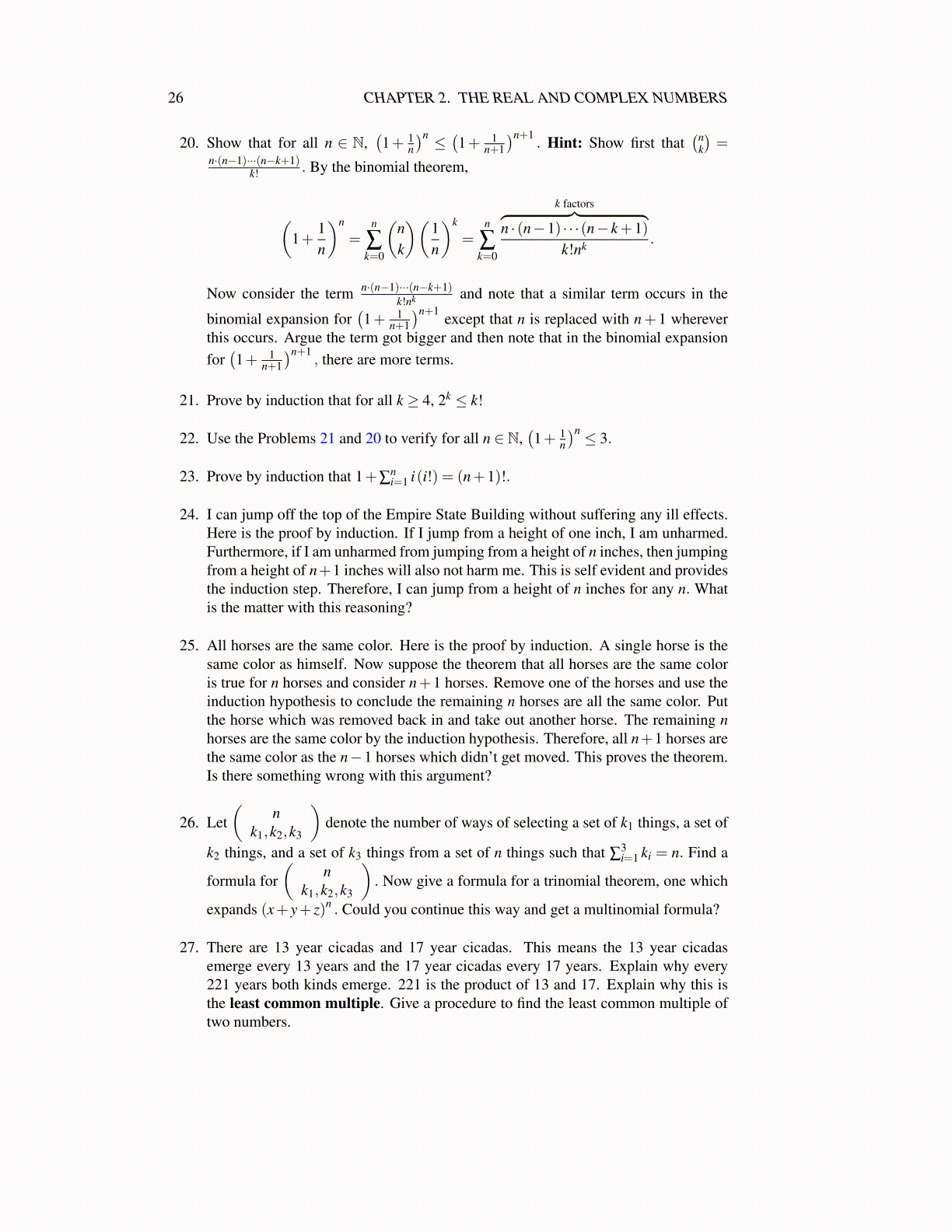
26 CHAPTER 2. THE REAL AND COMPLEX NUMBERS
from a height of n+1 inches will also not harm me. This is self evident and providesthe induction step. Therefore, I can jump from a height of n inches for any n. Whatis the matter with this reasoning?
25. All horses are the same color. Here is the proof by induction. A single horse is thesame color as himself. Now suppose the theorem that all horses are the same coloris true for n horses and consider n+1 horses. Remove one of the horses and use theinduction hypothesis to conclude the remaining n horses are all the same color. Putthe horse which was removed back in and take out another horse. The remaining nhorses are the same color by the induction hypothesis. Therefore, all n+1 horses arethe same color as the n−1 horses which didn’t get moved. This proves the theorem.Is there something wrong with this argument?
26. Let(
nk1,k2,k3
)denote the number of ways of selecting a set of k1 things, a set of
k2 things, and a set of k3 things from a set of n things such that ∑3i=1 ki = n. Find a
formula for(
nk1,k2,k3
). Now give a formula for a trinomial theorem, one which
expands (x+ y+ z)n . Could you continue this way and get a multinomial formula?
27. There are 13 year cicadas and 17 year cicadas. This means the 13 year cicadasemerge every 13 years and the 17 year cicadas every 17 years. Explain why every221 years both kinds emerge. 221 is the product of 13 and 17. Explain why this isthe least common multiple. Give a procedure to find the least common multiple oftwo numbers.
28. Show that there are infinitely many prime numbers. Hint: Suppose not and that theprimes are p1, ..., pn. Consider ∏k pk +1 and its prime factorization. Euclid showedthat there were infinitely many primes around 300 B.C.
2.10 Completeness of RBy Theorem 2.7.9, between any two real numbers, points on the number line, there existsa rational number. This suggests there are a lot of rational numbers, but it is not clear fromthis Theorem whether the entire real line consists of only rational numbers. Some peoplemight wish this were the case because then each real number could be described, not just asa point on a line but also algebraically, as the quotient of integers. Before 500 B.C., a groupof mathematicians, led by Pythagoras believed in this, but they discovered their beliefs werefalse. It happened roughly like this. They knew they could construct the square root of twoas the diagonal of a right triangle in which the two sides have unit length; thus they couldregard
√2 as a number. Unfortunately, they were also able to show
√2 could not be written
as the quotient of two integers. This discovery that the rational numbers could not evenaccount for the results of geometric constructions was very upsetting to the Pythagoreans,especially when it became clear there were an endless supply of such “irrational” numbers.
This shows that if it is desired to consider all points on the number line, it is necessaryto abandon the attempt to describe arbitrary real numbers in a purely algebraic mannerusing only the integers. Some might desire to throw out all the irrational numbers, andconsidering only the rational numbers, confine their attention to algebra, but this is notthe approach to be followed here because it will effectively eliminate every major theoremof calculus and analysis. In this book real numbers will continue to be the points on the